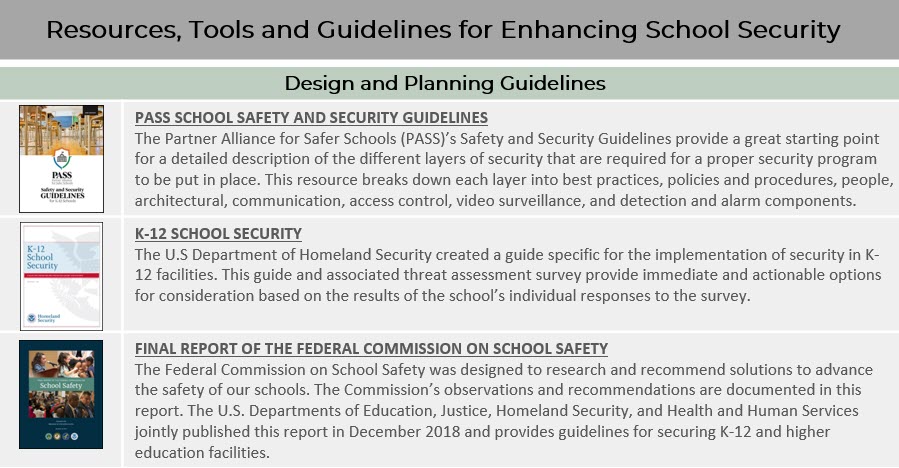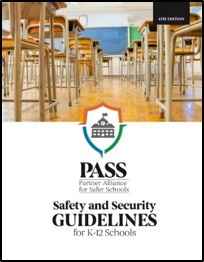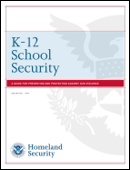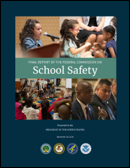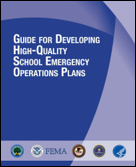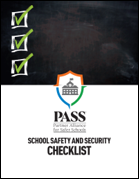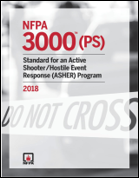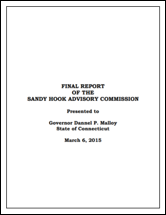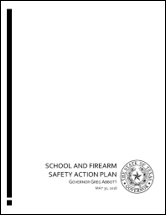Associate Principal Mike Niola participated in the Designing Safer Schools Workshop at the 2019 AIA National Conference on Architecture in Las Vegas. To augment the workshop materials, Mike compiled and discussed the following resources and tools from a variety of organizations as a reference for architects, school officials, and others who are interested in enhancing K-12 school security.
As you’d imagine, there is no shortage of published guides for school security and choosing the correct one(s) may be difficult. The list below represents the guides we view as the most comprehensive and applicable in the context of holistic security best practices. It is important to note that no single guide will be the definitive answer to every school’s security needs. Every environment is unique, but these resources include some of the key concepts to consider – security assessments, layered security, proper policies and procedures, community collaboration, key architectural components, and integrated security systems.
The resources are organized as follows:
- Design and Planning Guidelines – Resources for K-12 planners and designers seeking to learn how to consider security from the planning and design stages.
- Operational Guidelines and Checklists – Resources for individuals tasked with creating or executing security assessments, policies and procedures.
- Event-Specific Reports – Reports of studies and changes made after specific events have taken place. This provides a glance of how some jurisdictions have reacted after a tragedy and could be used to cross reference how they applied the security guidelines or why they did not.
We will continue to update this list as reports and guidelines evolve to accurately reflect the best practices reinforced through our direct experience working with school districts and design teams across the country.
Design and Planning Guidelines
PASS SCHOOL SAFETY AND SECURITY GUIDELINES
The Partner Alliance for Safer Schools (PASS)’s Safety and Security Guidelines provide a great starting point for a detailed description of the different layers of security that are required for a proper security program to be put in place. This resource breaks down each layer into best practices, policies and procedures, people, architectural, communication, access control, video surveillance, and detection and alarm components.
K-12 SCHOOL SECURITY
The U.S Department of Homeland Security created a guide specific for the implementation of security in K-12 facilities. This guide and associated threat assessment survey provide immediate and actionable options for consideration based on the results of the school’s individual responses to the survey.
FINAL REPORT OF THE FEDERAL COMMISSION ON SCHOOL SAFETY
The Federal Commission on School Safety was designed to research and recommend solutions to advance the safety of our schools. The Commission’s observations and recommendations are documented in this report. The U.S. Departments of Education, Justice, Homeland Security, and Health and Human Services jointly published this report in December 2018 and provides guidelines for securing K-12 and higher education facilities.
Operational Guidelines and Checklists
GUIDE FOR DEVELOPING HIGH-QUALITY SCHOOL EMERGENCY OPERATIONS PLANS
This Guide from the Federal Emergency Management Agency (FMEA) provides recommendations in the development of plans to respond to an emergency. It also outlines how K-12 Schools can plan to prevent, protect against, mitigate the impact of, and recover from these emergencies. The guide translates lessons learned from the Administration’s work on national preparedness to benefit from recent advancements in the emergency planning. It introduces new approaches to planning that includes walking through different emergency scenarios to create a course of action for each objective the team is trying to accomplish.
PASS SCHOOL SAFETY AND SECURITY CHECKLIST
The Partner Alliance for Safer Schools (PASS) School Safety and Security Checklist allows you to track your school or district’s security efforts in comparison to the best practices defined in the Guidelines.
Use this comprehensive list of the best practices detailed in the PASS Guidelines to assess what may need to be implemented by your school or district. You can identify whether you have the recommended school security best practice in place, in progress, needed for the future or not required for your facility.
STANDARD FOR AN ACTIVE SHOOTER/HOSTILE EVENT RESPONSE PROGRAM
This standard addresses how to respond to an active shooter event, in general, not specific to just the K-12 environment. This can be used for a more detailed look at what your response plan should include: from identifying hazards and assessing vulnerability to planning, resource management, and incident management at a command level, including competencies for first responders and recovery.
Event-Specific Reports
FINAL REPORT OF THE SANDY HOOK COMMISSION
Published in 2015, this report focuses on recommendations from the Sandy Hook Commission that was established by the Connecticut governor following the December 2012 shooting at Sandy Hook Elementary School in Newtown, Connecticut. The commission focused its work in three areas: Safe School Design and Operation; Law Enforcement, Public Safety, and Emergency Response; and Mental Health/Mental Wellness. The purpose was to make recommendations to help prevent similar incidents in the future.
SCHOOL AND FIREARM SAFETY ACTION PLAN
After the Santa Fe High School shooting incident in Texas, Governor Greg Abbot led a series of roundtable discussions to focus on possible improvements for the safety of Texas schools. Published in May 2018, this report summarizes the recommendations and proposals to make schools safer through increased law enforcement, better threat assessment and intervention, and mental health interventions.

